Do you have a question about the Haier 3U55S2SR5FA and is the answer not in the manual?
Instructions for proper disposal of the air conditioning product and its components.
Details on fluorinated greenhouse gases covered by the Kyoto Protocol and their handling.
Crucial safety warnings regarding operation, installation, and potential hazards.
Important cautions regarding installation, gas leakage, and animal interference.
Ensures installation by qualified professionals and details risks of improper installation.
Guidelines for electrical work, wiring, refrigerant handling, and leak prevention.
Importance of proper earthing and installing an earth leakage breaker.
Avoid flammable gas areas; prevent animals from interfering with the outdoor unit.
Guidelines for safe handling, transport, and storage of air conditioning units.
Table specifying minimum room areas based on refrigerant charge.
Steps for inspecting units upon unpacking and checking the installation environment.
Principles for safe installation including ventilation, fire prevention, and handling leaks.
Requirements for electrical work, wiring, and installer certification.
Procedures for mounting indoor units, piping layout, and pressure testing.
Instructions for securely fixing the outdoor unit and connecting pipes.
Procedures for vacuumizing the system and detecting refrigerant leaks.
Steps for post-installation inspection and conducting the initial operational test.
Steps for inspecting, discharging, recovering, and disassembling the unit for relocation.
Precautions for maintenance, especially regarding welding and personnel qualifications.
Guidelines for the maintenance environment, ventilation, and site setup.
Methods for leak detection and safety principles to follow during maintenance.
Procedures for system cleaning, vacuumizing, and maintaining electrical components.
Maintenance of intrinsically safe elements and refrigerant circuit removal.
Precautions for welding, including ventilation and ensuring no refrigerant is present.
Requirements for refrigerant charging, avoiding cross-contamination and ensuring correct storage.
Procedures for scrapping equipment, ensuring safe refrigerant recovery and disposal.
Key items to verify before proceeding with the installation of the unit.
List of tools required, categorized by exclusivity, restrictions, and incompatibility with R32.
Procedure for R32 leak testing, vacuum pump requirements, and evacuation time.
Procedure for charging R32 refrigerant and steps to take in case of leaks.
Comparison of R32 with other refrigerants and handling differences.
List of accessories supplied with the outdoor unit.
Guidelines for choosing a suitable location for the outdoor unit, considering noise and airflow.
Specific instructions for seacoast areas and unit mounting height.
Instructions for proper grounding, electrical safety, and precautions before the test run.
Diagrams showing installation layout, piping directions, and clearance requirements.
Ensuring installation ground strength and guidelines for foundation bolt installation.
Guidelines for wall clearance around the outdoor unit for optimal airflow.
Maximum allowable piping lengths and height differences between units.
Diagrams showing allowed level differences between indoor and outdoor units.
Procedures for installing refrigerant piping and performing drain work.
Specifications for tightening flare nuts, valve caps, and service ports with torque.
Procedure for purging air and performing leak detection after piping work.
Precautions for adding R32 refrigerant and charging the system.
Guidelines for handling pipes, bending, and selecting copper and insulation materials.
Instructions for using separate insulation pipes for gas and liquid refrigerant.
Procedure for cutting pipes, performing flaring, and ensuring proper drainage.
Warnings against using mineral oil, used piping, or incomplete flaring.
Steps for pumping down the system before relocation or disposal.
Requirements for electric wiring, grounding, and connecting terminals.
Instructions for connecting power and communication wires to the indoor unit terminals.
Diagram illustrating the wiring connections for the indoor and outdoor units.
Confirmation of works before test run and procedure for automatic wiring error check.
Explanation of LED indicators, numeric display, and communication status.
Table listing potential issues, their causes, and corresponding error codes.
Instructions for proper disposal of the air conditioning product and its components.
Details on fluorinated greenhouse gases covered by the Kyoto Protocol and their handling.
Crucial safety warnings regarding operation, installation, and potential hazards.
Important cautions regarding installation, gas leakage, and animal interference.
Ensures installation by qualified professionals and details risks of improper installation.
Guidelines for electrical work, wiring, refrigerant handling, and leak prevention.
Importance of proper earthing and installing an earth leakage breaker.
Avoid flammable gas areas; prevent animals from interfering with the outdoor unit.
Guidelines for safe handling, transport, and storage of air conditioning units.
Table specifying minimum room areas based on refrigerant charge.
Steps for inspecting units upon unpacking and checking the installation environment.
Principles for safe installation including ventilation, fire prevention, and handling leaks.
Requirements for electrical work, wiring, and installer certification.
Procedures for mounting indoor units, piping layout, and pressure testing.
Instructions for securely fixing the outdoor unit and connecting pipes.
Procedures for vacuumizing the system and detecting refrigerant leaks.
Steps for post-installation inspection and conducting the initial operational test.
Steps for inspecting, discharging, recovering, and disassembling the unit for relocation.
Precautions for maintenance, especially regarding welding and personnel qualifications.
Guidelines for the maintenance environment, ventilation, and site setup.
Methods for leak detection and safety principles to follow during maintenance.
Procedures for system cleaning, vacuumizing, and maintaining electrical components.
Maintenance of intrinsically safe elements and refrigerant circuit removal.
Precautions for welding, including ventilation and ensuring no refrigerant is present.
Requirements for refrigerant charging, avoiding cross-contamination and ensuring correct storage.
Procedures for scrapping equipment, ensuring safe refrigerant recovery and disposal.
Key items to verify before proceeding with the installation of the unit.
List of tools required, categorized by exclusivity, restrictions, and incompatibility with R32.
Procedure for R32 leak testing, vacuum pump requirements, and evacuation time.
Procedure for charging R32 refrigerant and steps to take in case of leaks.
Comparison of R32 with other refrigerants and handling differences.
List of accessories supplied with the outdoor unit.
Guidelines for choosing a suitable location for the outdoor unit, considering noise and airflow.
Specific instructions for seacoast areas and unit mounting height.
Instructions for proper grounding, electrical safety, and precautions before the test run.
Diagrams showing installation layout, piping directions, and clearance requirements.
Ensuring installation ground strength and guidelines for foundation bolt installation.
Guidelines for wall clearance around the outdoor unit for optimal airflow.
Maximum allowable piping lengths and height differences between units.
Diagrams showing allowed level differences between indoor and outdoor units.
Procedures for installing refrigerant piping and performing drain work.
Specifications for tightening flare nuts, valve caps, and service ports with torque.
Procedure for purging air and performing leak detection after piping work.
Precautions for adding R32 refrigerant and charging the system.
Guidelines for handling pipes, bending, and selecting copper and insulation materials.
Instructions for using separate insulation pipes for gas and liquid refrigerant.
Procedure for cutting pipes, performing flaring, and ensuring proper drainage.
Warnings against using mineral oil, used piping, or incomplete flaring.
Steps for pumping down the system before relocation or disposal.
Requirements for electric wiring, grounding, and connecting terminals.
Instructions for connecting power and communication wires to the indoor unit terminals.
Diagram illustrating the wiring connections for the indoor and outdoor units.
Confirmation of works before test run and procedure for automatic wiring error check.
Explanation of LED indicators, numeric display, and communication status.
Table listing potential issues, their causes, and corresponding error codes.
| Brand | Haier |
|---|---|
| Model | 3U55S2SR5FA |
| Category | Air Conditioner |
| Language | English |
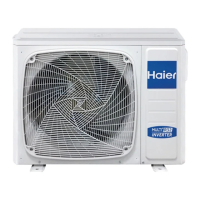
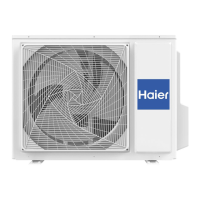
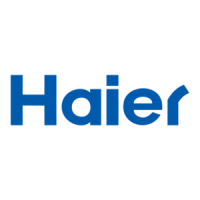





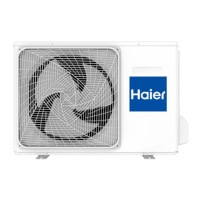
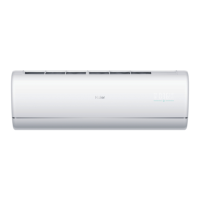
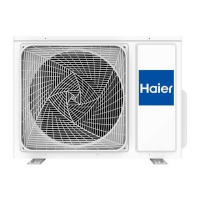

